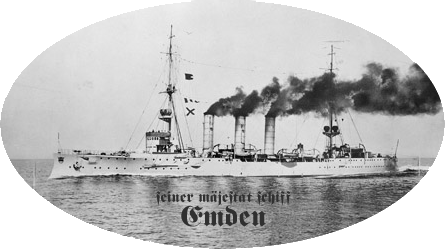
The white pacific corsair: Her 1914 odyssey would deserve a big budget Hollywood movie*.
The truly epic saga of SMS Emden and her crew began shortly after she entered into service in 1909. Sent to subdue the colony of Ponape, one of the Carolinas, she represented there the authority of the Kaiser. By the year 1914, she was detached to the colony of Tsing-Tao (SE China), an old Prussian historical trade post of the middle empire. On the day of the declaration of war in 1914, Commander Von Müller decided to leave the base quickly so as not to be cornered by a superior enemy.
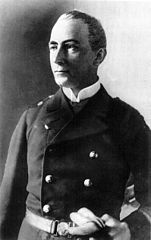 Other colonies (from the triple alliance) were close indeed, and the danger of Russian, French and English patrols was ever present. While joining Von Spee’s squadron in the Pacific through the Strait of Korea, SMS Emden boarded the Russian liner Riasan, whose crew was taken prisoner. However Admiral Jerram and his squadron arrived off Tsing tao, and Von Spee decided to try to return to the mainland and abandon the pacific. Fleeing south, because the Japanese entry into the war on 23 August, the Emden obtained to be able to stay and try a corsair war in the Indian Ocean.
Other colonies (from the triple alliance) were close indeed, and the danger of Russian, French and English patrols was ever present. While joining Von Spee’s squadron in the Pacific through the Strait of Korea, SMS Emden boarded the Russian liner Riasan, whose crew was taken prisoner. However Admiral Jerram and his squadron arrived off Tsing tao, and Von Spee decided to try to return to the mainland and abandon the pacific. Fleeing south, because the Japanese entry into the war on 23 August, the Emden obtained to be able to stay and try a corsair war in the Indian Ocean.
The Indian Ocean raider
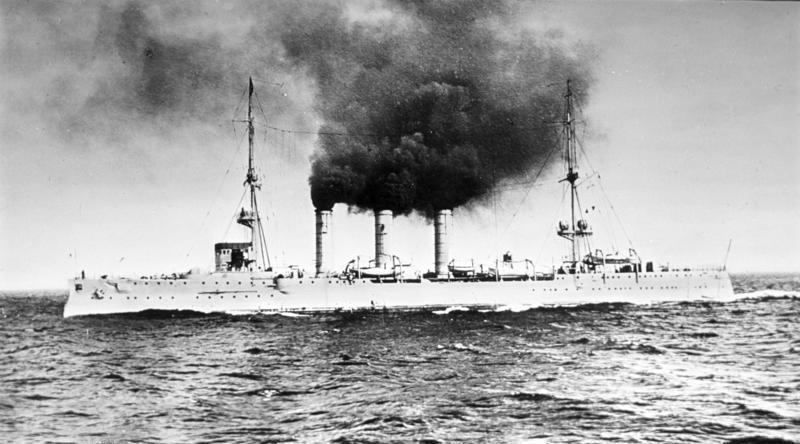
The SMS Emden at sea.
By leaving Spee, the white cruiser rampaging and preying on British shipping at will was to work as a diversion, allowing Von Spee’s squadron to sail to the Cape Horn without attracting too much attention. Thus, Emden crossed the shores of Indonesia, with a fourth fake chimney to be taken for an English Weymouth class cruiser, which precisely operated in these waters. Not seeing the Markomannia assisted by modest junks and coasters on September 8th, she then met the Greek coaler Pontoporos, neutral. Von Muller compelled, by means of finance, to dissuade the captain of the latter from going to deliver his cargo to Bombay. She became the second Emden coal supply ship instead. On the 10th of September, Emden seized the freighter “Indus”, loaded with food, which was seen as a blessing by the crew, and added extra range to this makeshift squadron.
However the ship was slow and her crew was transferred to the Markomannia, and sunk. The next day, the “Lovat”, a cargo, suffered the same fate. Later this day, it was the turn of the Kabinga, showing the English flag but carrying an American payload, bitterly seen by the boarding team when consulting the log book. In fact, it had not been sunk, but rather used to receive all prisoner crews, as well as later the small coaler Killin’s own cargo, also captured on the night of 14. “Von Müller’s squadron” counted by then four cargo ships in addition to the Emden herself. The Killin, after transfer of its cargo on the Kabinga, was sunk. The same day, it was the turn of the big “Diplomat” to be caught and sunk.
The chase began
However, Von Muller impunity had hitherto ceased the same day. Seizing the Italian cargo ship Loredano, and because of the triple alliance making the Italians allies of Germany, Von Muller was reluctant to let her go. Now on her guard, she made her way to her little squadron. Shortly after sending to the bottom the small coaster Trabboch, Von Müller finally intercepted by radio the message he most feared: The captain of the Loredano had spoken, and the hunt was now starting as since Von Muller’s position was known by the Admiralty.
Raiding British Ports
The Emden therefore leaved the Kabinga with all its crews on board and sailed at full speed. The news also caused maritime traffic to stop on this area, so no new prize will be taken. The Emden therefore attempted to attack the British ports on the Indian coast. On September 22, she raided the oil tanks of Madras, sending them volleys from 3000 meters. The weak English artillery could not counter-fire, leaving her to sail out unmolested, leaving all but burning wreckage, and replay this feat at Colombo. She gone as far as sinking a large transport of sugar in the harbour, wildly burning with a black panache kilometers high.
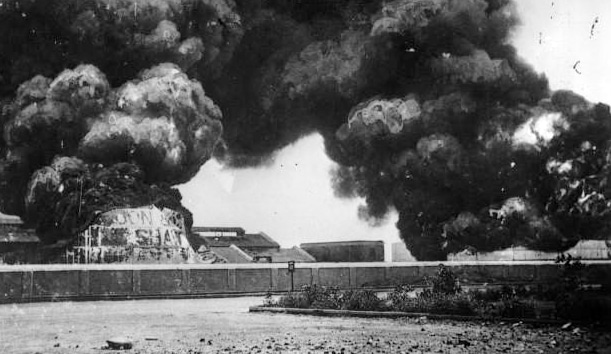
The raid on Madras
On Diego Garcia
But such an uproar attracted the English squadron. As far, the diversion perfectly working so much that Von Muller decided to keep a lower profile by hiding on the small and remote British island of Diego-Garcia, one of the Mauritius islands. As expected, Islanders did not had any fresh news for weeks, in fact, from well before the war. Von Müller of course briefed his staff and crew to kept shut about the state of war. Indeed the Emden, also still in its peace white colonial livery, came as for a “courtesy visit,” bearing the German National peace pavilion, and was well received by the Governor.
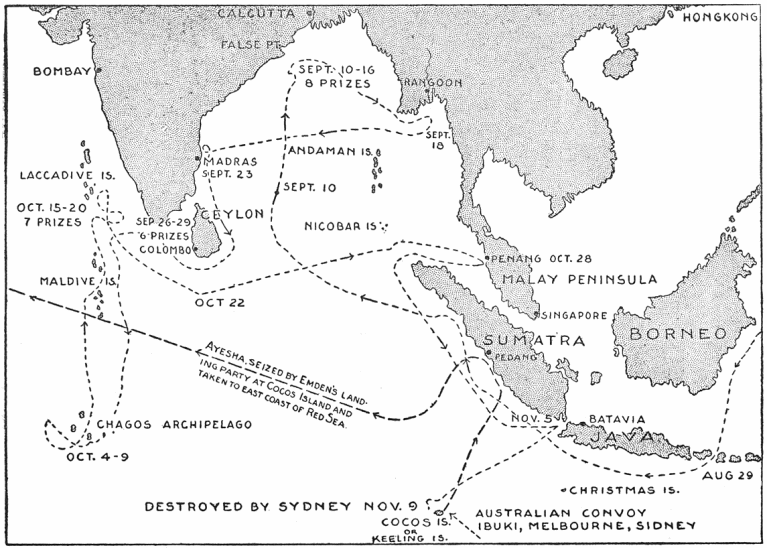
Emden’s 1914 cruise map
She can replenish serenely to the delight of the crew. In the drydock, she begins to make a new life when the TSF received warning of the imminent arrival of English ships. She left the island precipitately, and during the subsequent hangout, lost the cargo ship Markomannia. She then went hiding behind the island of Minnikoy, surprising and sinking no less than five English steamers in the process. The rescued crews were all transferred to the sixth.
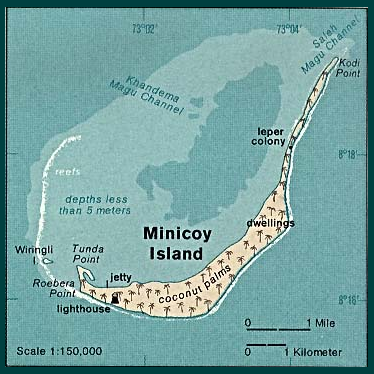
Minicoy Island (Now Maliku, SW Indian Ocean).
The British Admiralty was now at a standstill, for the national press was unleashed against German war prowess and feats at the expense of the Royal Navy, at the other end of the world. Numerous warships constantly patrolled these waters that Von Müller decided to leave and eventually rally Von Spee’s squadron via the Malacca strait. But this was barely the start of an amazing story for her crew…
The Battle of Penang
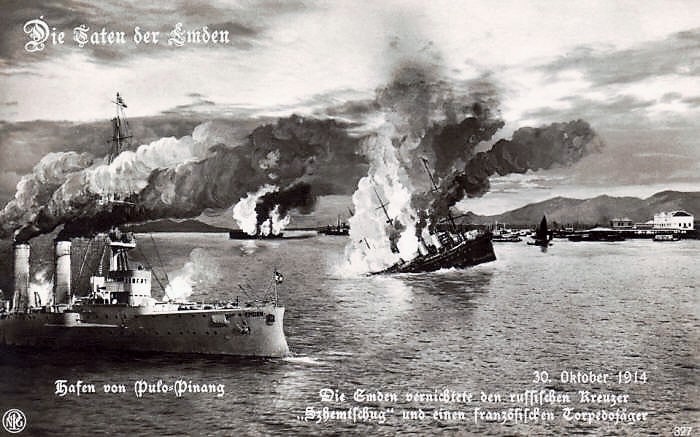
Battle of Penang, commemorative German postcard.
The Emden presented herself on the 28th of October, just before dawn, off Georgetown, all lights shut. There were four French ships, at anchor, the Torpedo cruiser d’Iberville and three destroyers. One of these, the Mousquet, was patrolling all night long, and did not realized anything. There was also nearby at anchor the more threatening Russian cruiser Jemtchug. Arrived at point-blank range in the middle of the harbour, the commander order to hoist the flag of war. While crews were still asleep, a torpedo was launched, blowing up the Jemtchoug. The latter remaining afloat, and all the Emden artillery pieces went ablase, ripping off the unfortunate Russian ship from bow to stern.
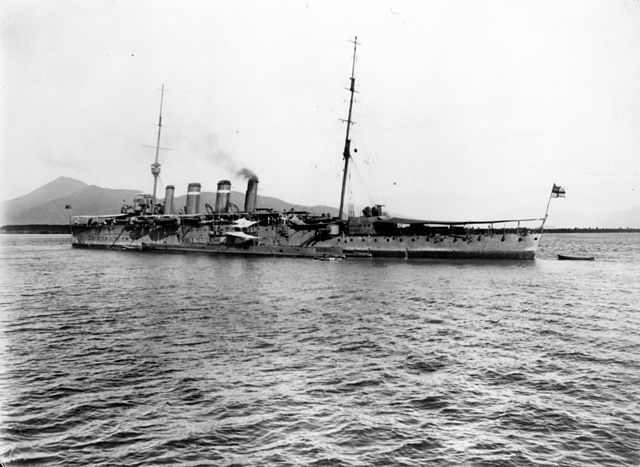
HMAS Sydney, Emden’s opponent. Its 152 mm, with greater range and caliber, left no chance to what was classed as a light cruiser, essentially.
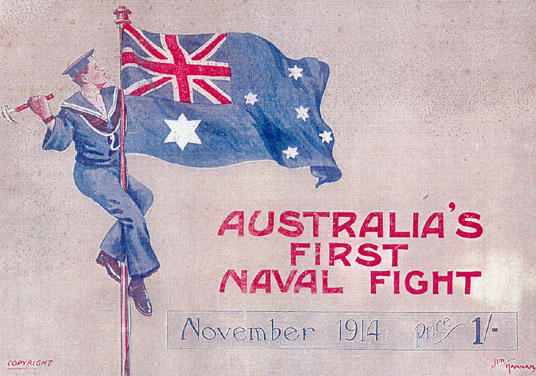
Commemoration postcard of Sydney’s first fight against the Emden.
Her crew however managed to put some of her 120 mm pieces in battery and open fire. The Emden launched a second torpedo, hitting the Jemtchug just in the ammunition hold. The Russian cruiser blew up skyhigh and sank in tens of seconds. Having sent down his flag, Von Muller had the nearby D’Iberville believing the cannonade was a mistake, and sent a signal that the French ship is not to be worried. But when Jemchug exploded, D’Iberville captain observed Emden’s fourth artificial chimney to be a fake, and realizing its sent the alarm. But by then the Emden is already too far for the Aviso’s puny guns.
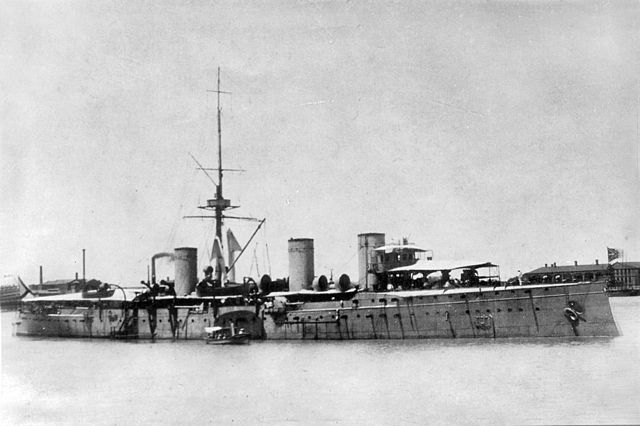
Russian Cruiser Jemtchug. It has been already badly damaged at Tsushima a few years before.
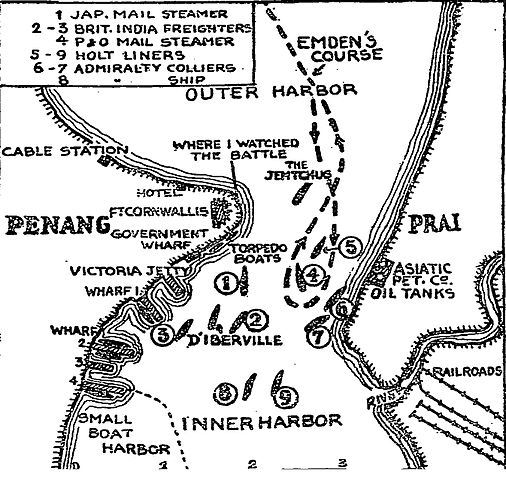
Map of the Raid and battle of Penang
The Cocos Islands Battle
The Emden then joined the Cocos Islands. One of these islands had a radio station that Von Müller wants to destroy, in order to refuel without being worried. But a message was sent nevertheless when the German cruiser presented itself. The report is given to Australian cruisers HMAS Melbourne and Sydney, which escorted a convoy not far away. Japanese Ibuki, another escort, is order to remain guarding the convoy.
Full speed ahead, the two ships arrived in sight of the Cocos just half an hour later. At this very moment, a German infantry company had disembarked, now attempting to cut the radio cables on Direction Island with improvised tools. Australian cruiser Sydney then fired a first burst of its 152 mm pieces, too long. Widely superior in artillery, it can only overwhelm the Emden which does not have now the resource to flee. Her captain would then try to get closer and open fire with her main lower range artillery. However this had no serious consequences for the Australian cruisers that countered her very effectively. The salvo that follows blew up the Emden telemetry station, disrupting her accuracy. When the Emden tried to come closer again, the Sydney evaded its range at full speed and replied without being worried.
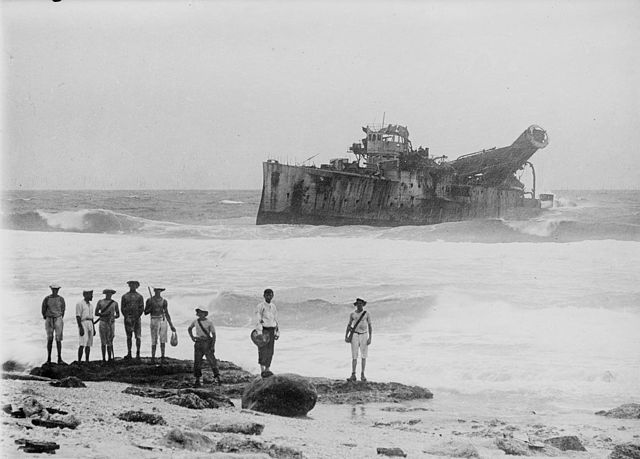
Emden’s wreck on North Keeling Island, took the day after.
At each salvo that weakened the Emden, losses were not replaced. Indeed, Von Mücke’s company had disembarked with fifty men and did followed the unequal action from the beach, the action wen so fast they never had any chance to get back onboard. Emden scored sixteen hits on Sydney, killing three of her crew and wounding another thirteen. But here fate was sealed. When all gun is silenced, her chimneys tumbled, her machines pierced, her steering damaged and her speed down to near zero, the German corsair is condemned. HMAS Sydney indeed poured 670 rounds of ammunition, and claimed about around 100 hits. Making water from all sides, Von Muller decided to beach the wounded ship with all engine power remaining onto the reefs of North Keeling.
Captain Glossop, from the observation deck of HMAS Sydney, ordered an approach, and after a first injunction to surrender, at first refused, and two warning salvoes, his face lightened up with satisfaction seeing at last the German white flag brought up. Meanwhile, 133 officers and enlisted men on the German ship died, out of a crew of 376. The remainder were either badly wounded or shocked, but still resolute: Von Muller indeed ordered to flood the engines and boilers, and throw overboard the breech blocks and torpedo aiming gear while and all signal books and secret papers were burned.
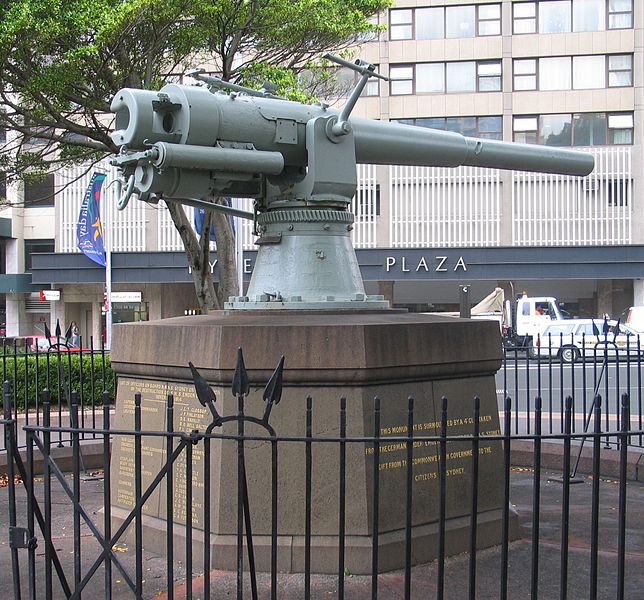
Emden’s 105 mm cannon trophy now in Hyde Park, Sydney.
The Sydney however leaved the beached Emden immediately after seeing the flag hoisted, going back to Direction Island, in order to land a company of riflemen to fight Von Mücke’s own men. But the latter meanwhile managed to storm the governor’s own schooner Ayesha, and sailed with all supplies available on board towards the island of Padang in the Dutch East Indies. Von Müller’s own men were taken prisoners the day after, the wounded men were interned in Australia while the uninjured were send to a POW camp in Malta. They only returned to Germany in 1920.
Sailing to Sumatra
Von Mücke’s infantry company, 50 strong, was then converted back as sailors, occupied by the rigging of the 95 metric tonnes schooner Ayesha all the way back to Sumatra. They crossed the path of rare ships in the process, unmoved by the white sailing ship showing a civilian flag. Eventually they managed to reach their destination on November, 7, but were refused all help by the Dutch. They waited and embarked in a German steamer which halted there, bound to Yemen. They disembarked a few days later near Bab-el-Mandeb, and Von Mücke’s leaved for an extraordinary journey back to Germany.
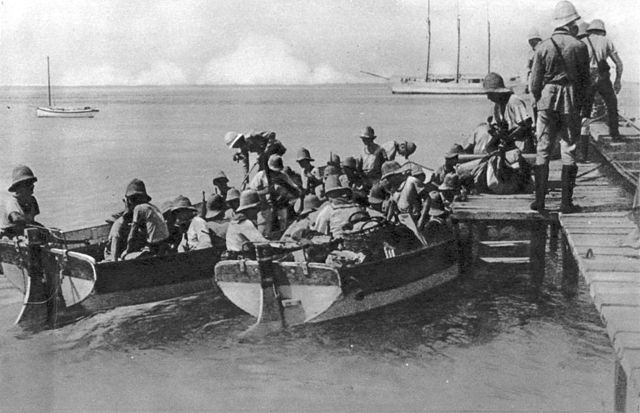
Von Mücke’s landing party at Direction Island. The governor’s schooner can bee seen in the foreground.
Von Mücke’s Arabian odyssey
The German commander started the long trip on foot and camel fom Bab-El-Mandeb, crossing all the Arabian peninsula, part foot, part on camel, as Yemen and Arabia were part of the Ottoman Empire, an ally of Germany. Well received by local tribes, they eventually managed after several weeks to join Constantinople in june 1915. There, they met fellow Vice-Admiral Souchon, head of the Turkish fleet onboard the Goeben. From there, they can finally, in June 1915, join the fatherland and embrace their family, being treated as heroes.
Epilogue
In three month the Emden covered about 30,000 nautical miles (56,000 km; 35,000 mi), destroyed two Entente warships and sank or captured sixteen British steamers, one Russian merchant ship, plus Russian Cruiser Jemtchug and French warships d’Iberville and Mousquet, totaling 70,825 gross register tons. Von Muller succeeded in its main objective, creating a diversion in order to leave Von Spee’s own Pacific Squadron to reach the cape Horn. The latter however will met his fate in the Falklands, first with success, by destroying Admiral Cradock’s own British squadron, before being wiped out by a British fleet countering two battlecruisers in the second Falklands battle. This was the end for German’s oversea fleet.
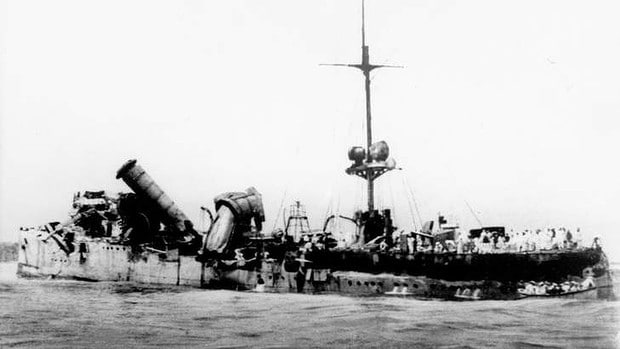
Kaiser Wilhelm II awarded the Iron Cross to the Emden, and announced that a new cruiser would be built to honor the original one. bearing a large Iron Cross on her bow to commemorate her namesake ship. It however was never achieved and instead a new one was built to serve with the postwar Reichsmarine. Under the Kriegsmarine flag and ww2, she managed herself to sink several Soviet destroyers, as the first of brand new Kriegsmarine cruisers. The named was honored in the Cold War with Köln-class frigate Emden (1959) and the Bremen-class frigate (1979) still in service. No doubt the legacy will endure for some time in the next Century.
 Movies about the Emden: How We Beat the Emden and How We Fought the Emden, 1928 The Exploits of the Emden, all produced in Australia. German, side 1926 silent Unsere Emden (footage) later incorporated in Kreuzer Emden, a 1932 feature film, and Heldentum und Todeskampf unserer Emden (1934). All three films were directed by Louis Ralph.
Movies about the Emden: How We Beat the Emden and How We Fought the Emden, 1928 The Exploits of the Emden, all produced in Australia. German, side 1926 silent Unsere Emden (footage) later incorporated in Kreuzer Emden, a 1932 feature film, and Heldentum und Todeskampf unserer Emden (1934). All three films were directed by Louis Ralph.
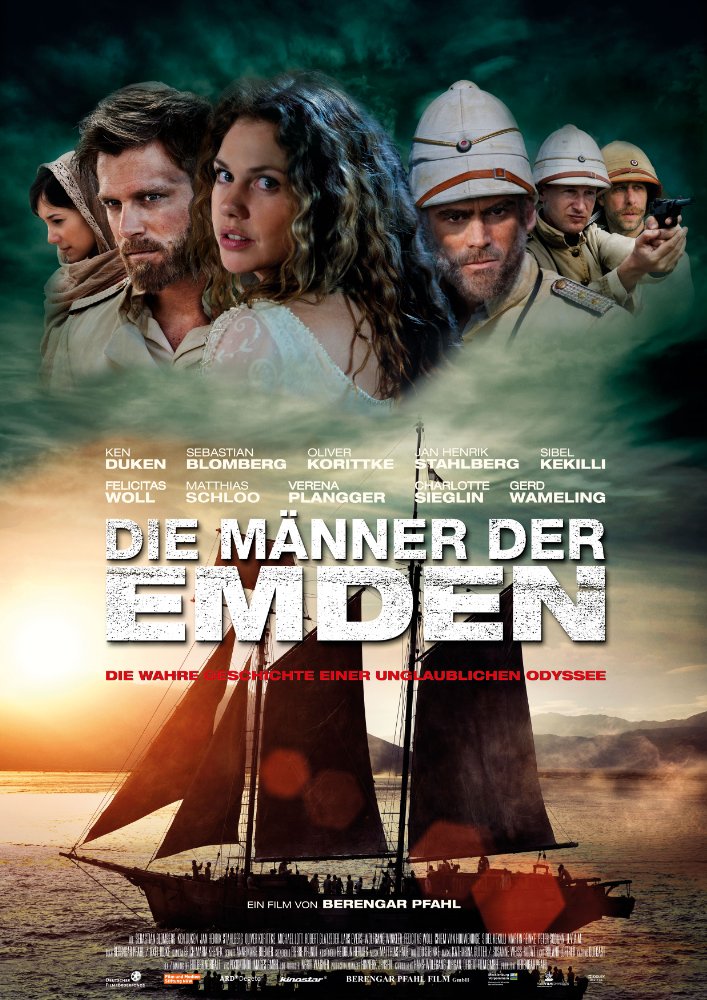 More recently, in 2012,Die Männer der Emden (The men of the Emden) was released, but only covering how Von Mücke’s men made their way back to Germany after the Battle of Cocos.
More recently, in 2012,Die Männer der Emden (The men of the Emden) was released, but only covering how Von Mücke’s men made their way back to Germany after the Battle of Cocos.
Read more:

 Latest Facebook Entry -
Latest Facebook Entry -  X(Tweeter) Naval Encyclopedia's deck archive
X(Tweeter) Naval Encyclopedia's deck archive Instagram (@navalencyc)
Instagram (@navalencyc)





 French Navy
French Navy Royal Navy
Royal Navy Russian Navy
Russian Navy Armada Espanola
Armada Espanola Austrian Navy
Austrian Navy K.u.K. Kriegsmarine
K.u.K. Kriegsmarine Dansk Marine
Dansk Marine Nautiko Hellenon
Nautiko Hellenon Koninklije Marine 1870
Koninklije Marine 1870 Marinha do Brasil
Marinha do Brasil Osmanlı Donanması
Osmanlı Donanması Marina Do Peru
Marina Do Peru Marinha do Portugal
Marinha do Portugal Regia Marina 1870
Regia Marina 1870 Nihhon Kaigun 1870
Nihhon Kaigun 1870 Preußische Marine 1870
Preußische Marine 1870 Russkiy Flot 1870
Russkiy Flot 1870 Svenska marinen
Svenska marinen Søværnet
Søværnet Union Navy
Union Navy Confederate Navy
Confederate Navy Armada de Argentina
Armada de Argentina Imperial Chinese Navy
Imperial Chinese Navy Marinha do Portugal
Marinha do Portugal Mexico
Mexico Kaiserliche Marine
Kaiserliche Marine 1898 US Navy
1898 US Navy Sovietskiy Flot
Sovietskiy Flot Royal Canadian Navy
Royal Canadian Navy Royal Australian Navy
Royal Australian Navy RNZN Fleet
RNZN Fleet Chinese Navy 1937
Chinese Navy 1937 Kriegsmarine
Kriegsmarine Chilean Navy
Chilean Navy Danish Navy
Danish Navy Finnish Navy
Finnish Navy Hellenic Navy
Hellenic Navy Polish Navy
Polish Navy Romanian Navy
Romanian Navy Turkish Navy
Turkish Navy Royal Yugoslav Navy
Royal Yugoslav Navy Royal Thai Navy
Royal Thai Navy Minor Navies
Minor Navies Albania
Albania Austria
Austria Belgium
Belgium Columbia
Columbia Costa Rica
Costa Rica Cuba
Cuba Czechoslovakia
Czechoslovakia Dominican Republic
Dominican Republic Haiti
Haiti Hungary
Hungary Honduras
Honduras Estonia
Estonia Iceland
Iceland Eire
Eire Equador
Equador Iran
Iran Iraq
Iraq Latvia
Latvia Liberia
Liberia Lithuania
Lithuania Mandchukuo
Mandchukuo Morocco
Morocco Nicaragua
Nicaragua Persia
Persia San Salvador
San Salvador Sarawak
Sarawak Uruguay
Uruguay Venezuela
Venezuela Zanzibar
Zanzibar Warsaw Pact Navies
Warsaw Pact Navies Bulgaria
Bulgaria Hungary
Hungary

 Bundesmarine
Bundesmarine Dutch Navy
Dutch Navy Hellenic Navy
Hellenic Navy Marina Militare
Marina Militare Yugoslav Navy
Yugoslav Navy Chinese Navy
Chinese Navy Indian Navy
Indian Navy Indonesian Navy
Indonesian Navy JMSDF
JMSDF North Korean Navy
North Korean Navy Pakistani Navy
Pakistani Navy Philippines Navy
Philippines Navy ROKN
ROKN Rep. of Singapore Navy
Rep. of Singapore Navy Taiwanese Navy
Taiwanese Navy IDF Navy
IDF Navy Saudi Navy
Saudi Navy Royal New Zealand Navy
Royal New Zealand Navy Egyptian Navy
Egyptian Navy South African Navy
South African Navy






























 Ukrainian Navy
Ukrainian Navy dbodesign
dbodesign